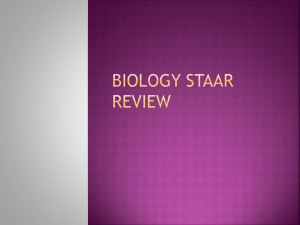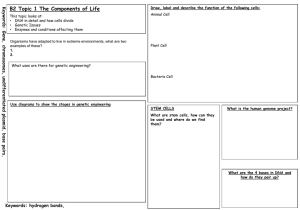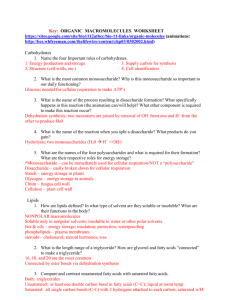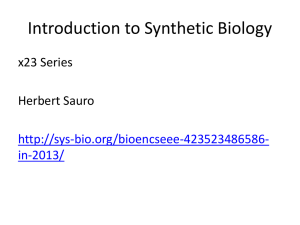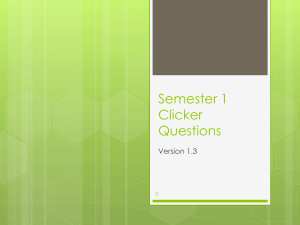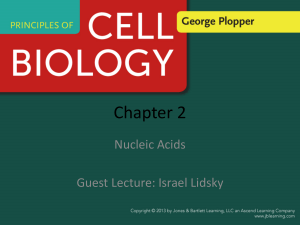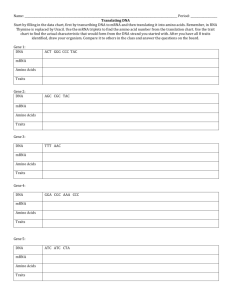Biology Starr review
advertisement
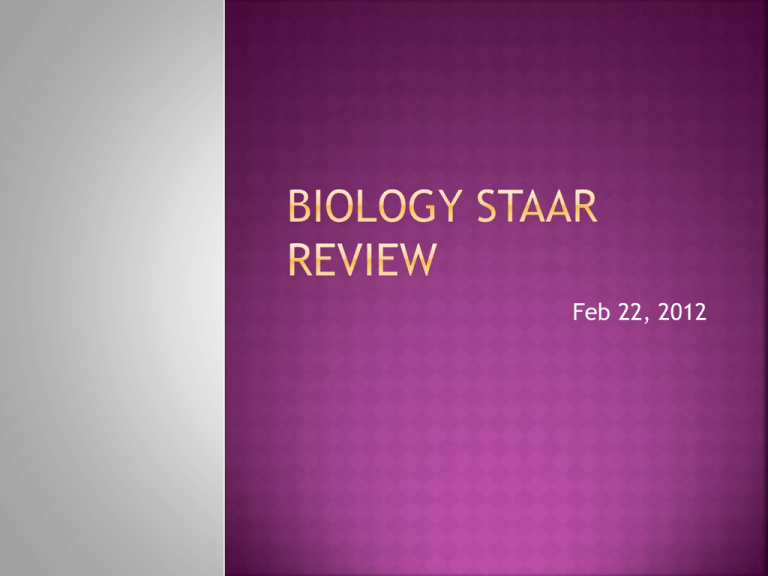
Feb 22, 2012 (4) Science concepts. The student knows that cells are the basic structures of all living things with specialized parts that perform specific functions and that viruses are different from cells. The student is expected to: Provides a selectively permeable barrier around the cell Controls the passage of substances in and out of the cell. Maintains homeostasis for the cell. Cells will shrivel when put into a solution with MORE SOLUTE. Ex. salt water (Hypertonic) If solute concentration is equal on both sides of the membrane, the cell does not change. (Isotonic) Cells will swell or burst when put into a solution with LESS SOLUTE Ex. Fresh water (Hypotonic) PASSIVE Does NOT require energy Goes with the concentration gradient (high to low) Simple Diffusion, Facilitated Diffusion ACTIVE Requires energy from ATP Goes against the concentration gradient (low to high) Active Transport, Endocytosis, Exocytosis Living prokaryote Non –living – not made of cells must reproduce in host cell ▪Lysogenic pathway The virus stays within the cell until certain environmental triggers cause it to enter the lytic cycle. ▪ A vaccine is a biological preparation that improves immunity to a particular disease. A vaccine typically contains an agent that resembles a disease-causing microorganism, and is often made from weakened or killed forms of the microbe. (5) Science concepts. The student knows how an organism grows and the importance of cell differentiation. During the cell cycle, cell grows, prepares for division, and divides to form two daughter cells , each which begins the cycle again. New DNA is formed during 3 phases: 4 phases: G1 – 1st period of growth (PMAT) 2. Makes new proteins and organelles. Mitosis 1. Increase in size. S1 – DNA is synthesized or replicated 1. Chromosomes are replicated. 2. New DNA molecules are synthesized. G2 – final cell growth 1. Shortest phase 2. Prepares cell for mitosis Interphase 1) 2) 3) 4) Prophase Metaphase Anaphase Telephase Cell division MITOSIS produces 2 identical diploid (2N) cells MEIOSIS produces 4 different haploid (N) cells (GAMETES) Causes of cancer smoking tobacco Radiation exposure Viral infection DNA determines an organism’s traits by controlling the manufacturing of proteins. The sequencing of nucleotides forms unique genetic information. (6) Science concepts. The student knows the mechanisms of genetics, including the role of nucleic acids and the principles of Mendelian Genetics. * PHOSPHATE group * SUGAR - deoxyribose * nitrogen bases (1of4) Adenine (A) Guanine (G) Cytosine (C) Thymine (T) purines pyrimidines EXAMPLE: Gene 1 - body covering GUA-AGC-UUA (Use chart to find amino acids) val - ser – leu The amino acids sequence will determine the trait. hairless RNA contains the base uracil (U) DNA has thymine (T) RNA molecule is single-stranded A codon designates an amino acid An amino acid may have more than one codon There are 20 amino acids, but 64 possible codons Some codons tell the ribosome to stop translating Transcription- mRNA leaves the nucleus through its pores and goes to the ribosomes Translation is the process of decoding the mRNA into a polypeptide chain replication crossing over error of error of • DELETION – • DUPLICATION – • repeat a segment INVERSION – • loss of a chromosomal segment reverses a segment TRANSLOCATION – move segment from one chromosome to another 4 haploid (N) cells Genetically different from each other & the original cell Is the direct human manipulation of an organism's genome using modern DNA technology. Examples o o o Cloning Gene therapy Genetically engineered plants (7) Science concepts. The student knows evolutionary theory is a scientific explanation for the unity and diversity of life. Fossil record Similar characteristics due to relatedness are known as homologies. Homologies Another example of homology is the forelimb of tetrapods (vertebrates with legs). Snakes have legged ancestors. Some species of living snakes have hind limbbuds as early embryos but rapidly lose the buds and develop into legless adults. The study of developmental stages of snakes, combined with fossil evidence of snakes with hind limbs, supports the hypothesis that snakes evolved from a limbed ancestor. Different species share genetic homologies as well as anatomical ones. Roundworms, for example, share 25% of their genes with humans. These fundamental similarities are most easily explained by evolutionary theory: life shares a common ancestor. Divergent Evolution is also known as Adaptive Radiation Evolutionary Stasis occurs when one or many species remain the same genetically with little change over long geological periods of time Darwin’s finches 31 http://evolution.berkeley.edu/evolibrary/home.php WHAT OTHER INDUSTRIES WOULD BE WORRIED ABOUT RESISTANCE? Life Sciences-HHMI Outreach. Copyright 2006 President and Fellows of Harvard College. ALL IMAGES: http://evolution.berkeley.edu/evolibrary/home.php Life Sciences-HHMI Outreach. Copyright 2006 President and Fellows of Harvard College. (8) Science concepts. The student knows that taxonomy is a branching classification based on the shared characteristics of organisms and can change as new discoveries are made. The student is expected to: (9) Science concepts. The student knows the significance of various molecules involved in metabolic processes and energy conversions that occur in living organisms. COMPOSITION/STRUCTURE C, H, O FUNCTION MAIN SOURCE OF ENERGY TYPE/EXAMPLES GLUCOSE, GLYCOGN, FRUCTOSE, CELLULOSE, POLYSACCHARIDES, MONOSACCHARIDS, STARCH COMPOSITION/STRUCTURE C,H,O ONE GLYCEROL & 3 FATTY ACIDS FUNCTION •STORES ENERGY •MAIN COMPONENT OF CELL MEMBRANE •WATERPROOF COVERING TYPE/EXAMPLES FATS, OILS, POLYUNSATURATED COMPOSITION/STRUCTURE C, H, O, N LONG CHAINS OF AMINO ACIDS FUNCTION BUILD MUSCLES, CELL MEMBRANES TYPE/EXAMPLES ENZYMES COMPOSITION/STRUCTURE C, H, O, N, & P FUNCTION STORE & TRANSMIT GENETIC INFO TYPE/EXAMPLES DNA, RNA, NUCLEOTIDES Large organic molecules are created by the process of POLYMERIZATION. Mono=1 poly=many Photosynthesis Cellular Respiration Lower activation energy Speed up chemical reactions that take place in cells. Make materials cells need Releasing energy Temperature PH Salt (11) Science concepts. The student knows that biological systems work to achieve and maintain balance. The student is expected to: • Abiotic factors include any physical, or nonliving, part of the environment. • Biotic factors include any living part of the environment. Autotrophs/ Producers (Photosynthetic and Chemosynthetic) Heterotrophs/Consumers (Herb-/Carn-/Omn-ivores and Decomposers) (12) Science concepts. The student knows that interdependence and interactions occur within an environmental system. The student is expected to: THE THREE SYMBIOTIC RELATIONSHIPS ARE... PARASITISM MUTUALISM COMMENSALISM Food Chains = a series of steps in which organisms transfer energy by eating and being eaten Trophic Levels = each step in a food chain or food web Main Source Energy flow through an Ecosystem “Autotrophs” “Producers” “Heterotrophs” “Consumers” Nutrient Cycles The Carbon Cycle The Nitrogen Cycle Proteins 78% Nitrogen Fixation
